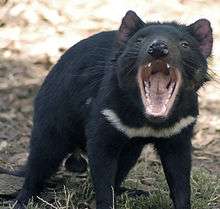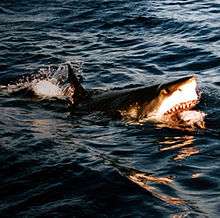List of apex predators
This is a partial list of apex predators—those predators that are not preyed upon as healthy adults in the wild. Full scavengers (e.g. most vultures), although they may not be preyed on either, are not counted as apex predators unless they at least partially depend on capturing live prey. Many species listed here are only apex predators within certain environments, e.g. coyotes are only apex predators when larger predators such as the gray wolf or the brown bear are absent.
Extant predators
These living carnivores or omnivores are apex predators.
.jpg)


Terrestrial
- African golden cat - (Caracal aurata)
- African rock python - (Python sebae)
- American badger - (Taxidea taxus)
- American black bear - (Ursus americanus)
- Andean cat - (Leopardus jacobita)
- Asian badger - (Meles leucurus)
- Asian golden cat - (Catopuma temminckii)
- Asian water monitor - (Varanus salvator)
- Bay cat - (Catopuma badia)
- Black-footed cat - (Felis nigripes)
- Black-headed bushmaster - (Lachesis melanocephala)
- Black mamba - (Dendroaspis polylepis)
- Blood python - (Python curtus)
- Bobcat - (Lynx rufus)
- Brown bear - (Ursus arctos)
- Brown tree snake* - (Boiga irregularis)
- Burmese python - (Python bivittatus)
- Canada lynx - (Lynx canadensis)
- Caracal - (Caracal caracal)
- Cat - (Felis catus)
- Central American bushmaster - (Lachesis stenophrys)
- Cheetah - (Acinonyx jubatus)
- Chinese mountain cat - (Felis bieti)
- Colocolo - (Leopardus colocolo)
- Bobcat - (Lynx rufus)
- Bonobo - (Pan paniscus)
- Bornean clouded leopard - (Neofelis diardi)
- Common chimpanzee - (Pan troglodytes)
- Clouded leopard - (Neofelis nebulosa)
- Cougar - (Puma concolor)
- Coyote - (Canis latrans)
- crocodile- (crocodylinae)
- Crocodile monitor - (Varanus salvadorii)
- Culpeo* - (Lycalopex culpaeus)
- Diamond python - (Morelia spilota spilota)
- Eastern diamondback rattlesnake - (Crotalus adamanteus)
- Ethiopian wolf - (Canis simensis)
- European badger - (Meles meles)
- Eurasian lynx - (Lynx lynx)
- Ferret - (Mustela putorius furo)
- Fisher - (Martes pennanti)
- Fishing cat - (Prionailurus viverrinus)
- Flat-headed cat - (Prionailurus planiceps)
- Fossa - (Cryptoprocta ferox)
- Gaboon viper - (Bitis gabonica)
- Geoffroy's cat - (Leopardus geoffroyi)
- Gray wolf - (Canis lupus)*
- Honey badger - (Mellivora capensis)
- Human - (Homo sapiens)**
- Iberian lynx - (Lynx pardinus)
- Inland taipan - (Oxyuranus microlepidotus)
- Iriomote cat - (Prionailurus iriomotensis)
- Island fox - (Urocyon littoralis)
- Jaguar - (Panthera onca)
- Jaguarundi - (Puma yagouaroundi)
- Jungle cat - (Felis chaus)
- Kodkod - (Leopardus guigna)
- Komodo dragon - (Varanus komodoensis)
- Lace monitor - (Varanus varius)
- Leopard - (Panthera pardus)
- Leopard cat - (Prionailurus bengalensis)
- Lion - (Panthera leo)
- Mandrill - (Mandrillus sphinx)
- Maned wolf - (Chrysocyon brachyurus)
- Marbled cat - (Pardofelis marmorata)
- Margay - (Leopardus weidii)
- Mulga snake - (Pseudechis australis)
- Nile monitor - (Varanus niloticus)
- Ocelot - (Leopardus pardalis)
- Oncilla - (Leopardus tigrinus)
- Pale fox - (Vulpes pallida)
- Pallas's cat - (Otocolobus manul)
- Pampas cat - (Leopardus pajeros)
- Perentie - (Varanus giganteus)
- Raccoon - (Procyon lotor)
- Red fox - (Vulpes vulpes)
- Red-Tailed Boa Constrictor - (Boa constrictor)
- Red wolf - (Canis rufus)
- Rusty-spotted cat - (Prionailurus rubiginosus)
- Sand cat - (Felis margarita)
- Scrub python - (Morelia amethistina)
- Serval - (Leptailurus serval)
- Small Asian mongoose* - (Herpestes javanicus)
- Snow leopard - (Panthera uncia)
- Spotted hyena- (Crocuta crocuta)
- South American bushmaster - (Lachesis muta)
- Sunda clouded leopard - (Neofelis diardi)
- Tasmanian devil - (Sarcophilus harrisii)
- Tiger - (Panthera tigris)
- Timber rattlesnake - (Crotalus horridus)
- Least weasel - (Mustela nivalis)
- Western diamondback rattlesnake - (Crotalus atrox)
- Wildcat - (Felis silvestris)
- Wolverine - (Gulo gulo)
- Yellow-headed water monitor - (Varanus cumingi)
- Yellow monitor - (Varanus flavescens)
- The grey wolf as a species includes the dingo and all domestic dogs.

Aerial
- African harrier-hawk - (Polyboroides typus)
- Antarctic skua - (Stercorarius antarcticus)
- Barred eagle owl - (Bubo sumatranus)
- Bald eagle - (Haliaeetus leucocephalus)
- Blakiston's fish owl - (Bubo blakistoni)
- Brown fish owl - (Bubo zeylonensis)
- Cape eagle owl - (Bubo capensis)
- Common raven - (Corvus corax)
- Common vampire bat - (Desmodus rotundus)
- Crested eagle - (Morphnus guianensis)
- Crowned eagle - (Stephanoaetus coronatus)
- Dragonfly - (Odanata)
- Eurasian eagle owl - (Bubo bubo)
- Forest eagle owl - (Bubo nipalensis)
- Golden eagle - (Aquila chrysaetos)
- Goliath heron - (Ardea goliath)
- Great black-backed gull - (Larus marinus)
- Great horned owl - (Bubo virginianus)
- Great skua - (Stercorarius skua)
- Harpy eagle - (Harpia harpyja)
- Harris hawk - (Parabuteo unicinctus)
- Lappet-faced vulture - (Torgos tracheliotos)
- Martial eagle - (Polemaetus bellicosus)
- New Guinea harpy eagle - (Harpyopsis novaeguineae)
- New Zealand falcon - (Falco novaeseelandiae)
- New Zealand harrier - (Circus approximans)
- Northern giant petrel - (Macronectes halli)
- Osprey - (Pandion haliaetus)
- Pel's fish owl - (Scotopelia peli)
- Peregrine falcon - (Falco peregrinus)
- Philippine eagle - (Pithecophaga jefferyi)
- Powerful owl - (Ninox strenua)
- Rock eagle owl - (Bubo bengalensis)
- Red-tailed hawk - (Buteo jamaicensis)
- Shelley's eagle owl - (Bubo shelleyi)
- South polar skua[1] - (Stercorarius maccormicki)
- Southern giant petrel - (Macronectes giganteus)
- Steller's sea eagle - (Haliaeetus pelagicus)
- Tawny fish owl - (Bubo flavipes)
- Verreaux's eagle owl - (Bubo lacteus)
- Wedge-tailed eagle - (Aquila audax)
- White-tailed eagle - (Haliaeetus albicilla)



.jpg)
Aquatic
- African lungfish
- Alligator snapping turtle
- Alligator gar
- American alligator
- American crocodile
- Arapaima
- Atlantic goliath grouper
- Baiji (Chinese river dolphin)
- Baikal seal
- Beluga sturgeon
- Black caiman
- Black grouper
- Black marlin
- Blue Whale
- Atlantic blue marlin
- Boto (Amazon river dolphin)
- Bull shark
- Common snapping turtle
- Electric catfish
- Electric ray
- Esox lucius
- False gharial
- False killer whale
- Gharial
- Giant freshwater stingray
- Giant grouper
- Giant otter
- Giant Pacific octopus
- Giant salamander
- Giant snakehead
- Giant trevally[2]
- Goonch catfish
- Goliath tigerfish
- Great barracuda
- Greenland shark
- Great blue heron
- Great white shark
- Kaluga (fish)
- Killer whale
- Lake trout[3]
- Largemouth bass
- Leatherback sea turtle
- Leopard seal[4]
- Lionfish
- Lion's mane jellyfish
- Loggerhead sea turtle
- Marlin
- Mediterranean monk seal[5]
- Moray eel
- Murray cod
- Muskellunge
- Nassau grouper
- Nile crocodile
- Nile perch
- Northern pike
- Piraíba
- Pseudoplatystoma (Surubí)
- Redtail catfish
- Salmon shark
- Saltwater crocodile
- Sailfish
- Stingray
- Sawfish
- South Asian river dolphin
- Semutundu catfish
- Smallmouth bass[3]
- Sperm whale
- Swordfish
- Syrinx aruanus
- Tiger shark
- Tigerfish
- Tuna
- Walleye
- Wels catfish
- Whale shark
- White grouper
- White sturgeon
- Vundu
- Zungaro zungaro (Jau)
Pagophilic
- Polar bear - (Ursus maritimus)
Notes: Animals with an asterisk (*) are only apex predators as introduced species. (**) Humans have debatable status[6]
Extinct apex predators
Dinosaurs
The carnivorous theropods listed below were likely apex predators based on their size and dietary needs. Because very few prehistoric ecosystems are known in detail, these are merely suggestions - larger, more dominant theropods might have lived during the same time in the same place.



- Abelisaurus
- Acrocanthosaurus
- Aerosteon
- Afrovenator
- Alectrosaurus
- Allosaurus
- Albertosaurus
- Altispinax
- Appalachiosaurus
- Aublysodon
- Aucasaurus
- Australovenator
- Austrocheirus
- Becklespinax
- Carcharodontosaurus
- Carnotaurus
- Chilantaisaurus
- Concavenator
- Cryolophosaurus
- Daemonosaurus
- Daspletosaurus
- Deltadromeus
- Dilophosaurus
- Dryptosaurus
- Dubreuillosaurus
- Eocarcharia
- Eustreptospondylus
- Fosterovenator
- Fukuiraptor
- Giganotosaurus
- Gorgosaurus
- Herrerasaurus
- Ilokelesia
- Indosuchus
- Kryptops
- Labocania
- Liliensternus
- Lourinhanosaurus
- Lythronax
- Majungasaurus
- Mapusaurus
- Megalosaurus
- Megaraptor
- Metriacanthosaurus
- Monolophosaurus
- Nanuqsaurus
- Neovenator
- Orkoraptor
- Poekilopleuron
- Pycnonemosaurus
- Qianzhousaurus
- Quilmesaurus
- Rahiolisaurus
- Rajasaurus
- Sauroniops
- Saurophaganax
- Siamosaurus
- Siamotyrannus
- Siats
- Sinotyrannus
- Sinraptor
- Skorpiovenator
- Spinosaurus
- Spinostropheus
- Staurikosaurus
- Szechuanosaurus
- Tarascosaurus
- Tarbosaurus
- Teratophoneus
- Torvosaurus
- Tyrannosaurus
- Tyrannotitan
- Vitakridrinda
- Yangchuanosaurus
- Yutyrannus
- Zhuchengtyrannus
- Zupaysaurus
Other prehistoric terrestrial apex predators

- Agriotherium
- Amphicyon
- Andrewsarchus
- Archaeotherium
- Arctodus simus
- Arctotherium
- Bathornis
- Borhyaena
- Brontornis
- Canis dirus
- Cynotherium sardous
- Daeodon
- Dimetrodon
- Dinofelis
- Entelodon
- Eotitanosuchus
- Epicyon
- Fasolasuchus
- Gorgonops
- Homotherium
- Hyaenodon
- Inostrancevia
- Kaprosuchus
- Kelenken
- Macroeuphractus
- Madtsoia
- Megalania
- Megistotherium
- Miracinonyx
- Neanderthal
- Ornimegalonyx
- Ornithosuchus
- Panthera onca gombagenzis
- Panthera leo atrox
- Panthera leo melanochaita
- Panthera leo spelaea
- Panthera tigris acutidens
- Paracrax
- Phorusrhacos
- Postosuchus
- Pristichampsus
- Sarkastodon
- Saurosuchus
- Smilodon
- Thylacine
- Thylacoleo
- Thylacosmilus
- Titanis
- Titanoboa
- Ursus maritimus tyrannus
Prehistoric aerial apex predators

- Arambourgiania
- Argentavis
- Haast's eagle
- Harpactognathus
- Hatzegopteryx
- Meganeura
- Meganeuropsis
- Quetzalcoatlus
- Sericipterus
- Teratornis
Prehistoric aquatic apex predators
- Aegisuchus
- Anomalocaris
- Basilosaurus
- Brygmophyseter
- Cameroceras
- Dakosaurus
- Deinosuchus
- Dunkleosteus
- Temnodontosaurus
- Jaekelopterus
- Koolasuchus
- Kronosaurus
- Liopleurodon
- Livyatan melvillei
- Megalodon
- Mosasaurus
- Pliosaurus
- Pterygotus
- Prionosuchus
- Proterogyrinus
- Purussaurus
- Redondasaurus
- Rhizodus
- Sarcosuchus
- Tylosaurus
References
- ↑ Bargagli, Roberto (2004). Antarctic Ecosystems. Springer. pp. 282–287. ISBN 3-540-22091-7.
- ↑ DeMartini, Edward E., Friedlander, Alan M., and Holzwarth, Stephani R. (2005). "Size at sex change in protogynous labroids, prey body size distributions, and apex predator densities at NW Hawaiian atolls". Marine ecology progress series 297: 259 -271. ISSN 0171-8630. Retrieved on 2006-12-21.
- 1 2 Lepak, Jesse M., Kraft, Clifford E., and Weidel, Brian C. (2006). "Rapid Food Web Recovery in Response to Removal of an Introduced Apex Predator". Canadian Journal of Fisheries and Aquatic Sciences 63(3): 569-575. ISSN 0706-652X. Retrieved on 2006-12-13.
- ↑ Kuhn, Carey E., McDonald, Birgitte I., Shaffer, Scott A., Barnes, Julie, Crocker, Daniel E., Burns, Jennifer, and Costa, Daniel P. (2006). "Diving physiology and winter foraging behavior of a juvenile leopard seal (Hydrurga leptonyx)". Polar Biology 29(4): 303-307. ISSN 0722-4060. Retrieved on 2006-12-21.
- ↑ Levner, Eugene; Linkov, Igor; Proth, Jean-Marie (2005). Strategic Management of Marine Ecosystems. Springer. p. 41. ISBN 1-4020-3158-0.
- ↑ Roopnarine, PD (2014). "Humans are apex predators". Proc. Natl. Acad. Sci. U.S.A. 111: E796. doi:10.1073/pnas.1323645111. PMC 3948303
 . PMID 24497513.
. PMID 24497513.